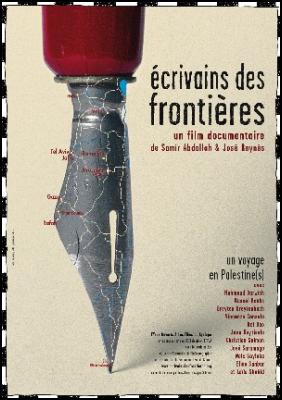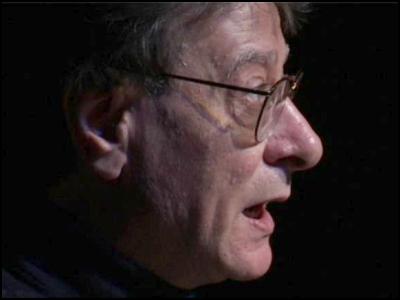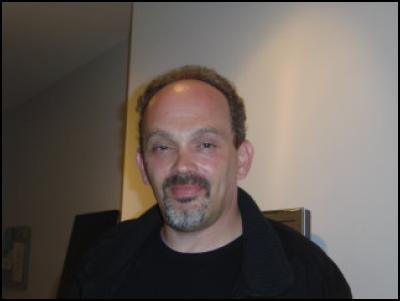Film Review And Response: Writers On The Borders
Film Review And Response: Writers On The Borders
By Sonia Nettnin

In seconds, the chainsaw sliced the branches of the olive trees. Israeli soldiers stood with Uzis nearby, in case the family intervened in the destruction of their orchard.The owner is in tears.
“How will I feed my children now,” he said.
A field of olive trees, 15 hectares, confiscated and destroyed for a road. It will lead to Israel’s security wall. “This wall of injustice and racism,” he said.
The branches hit the ground.
-all film and artistic images courtesy of ecrivainsdesfrontieres.org
The U.S. premiere of WRITERS ON THE BORDERS (ECRIVAINS DES FRONTIERES,) showed at the Gene Siskel Film Center on Sunday.
The third annual Chicago Palestine Film Festival hosted the screening, along with one of the film’s directors, Samir Abdallah.
Directed by Abdallah and Jose Reynes, the documentary is about eight writers who visit renowned Palestinian poet, Mahmoud Darwish, in Palestine. The eight members of the delegation are from the International Parliament of Writers. They include: Russel Banks, American novelist; Breyten Breytenbach, South African poet and novelist; Vincenzo Consolo, Italian novelist; Bei Dao, Chine poet exiled in the U.S; Juan Goytisolo, Spanish novelist; Christian Salmon, French author; Jose Saramago, Portuguese novelist; Wole Soyinka, Nigerian author; Elias Sanbar, Palestinian historian; and Leila Shadid, Palestinian artist-translator. Other artists and writes in the film include: Ahmad Dabour, Palestinian playwright and poet; Hassan Al-Kashib, Palestinian author; Uri Avnery, writer and member of Gush Shalom; Raji Sourani, director of the Palestinian Center for Human Rights; and Yehudit Harel, Israeli peace activist. In March 2002, the writers came together in solidarity with the Palestinian people – and they bore witness to the living conditions in the West Bank and Gaza.
In a Ramallah theater, Darwish recites: “Here on the slope of the hills facing the dusk and the canon of time, / Near the garden of broken shadows, /…we cultivate hope.”
Everyone roars with a standing applause.
Then, Salmon stands at the podium. He said he just learned the Arabic word, “Sabreen,” which means those who have patience.
They wrote about their experiences and compiled them into the book LE VOYAGE EN PALESTINE. The film utilizes excerpts from the book because their written experiences project the film. Moreover, the film is a narrative record of their journey, a visual account of events and their reflections as witnesses.
Banks describes the gathering as a linguistic collaboration of Palestinian poets and storytellers, alongside poets and storytellers in the international community. They want the Palestinian narrative heard by the rest of the world.
Darwish expresses that with hope, independence, liberation, love, peace, and truth “our poets will see the beauty of the color red in roses, rather than in blood.” The scene moves between Darwish’s speech and people on rooftops flying kites in the sky. The actions with his words symbolize freedom-in-action with these movements. The motion of a boy’s arms as he guides the string is a gesture of the peoples’ desire for peace.
After an Israeli invasion of Rafah, the delegation witnesses the destruction. In less than two hours, Israeli forces injured and killed dozens of civilians. Israeli tanks and bulldozers destroyed 400 houses and left 1700 homeless.

-a Palestinian man stands with the ruins of his home
“Look, we were unable to save anything,” one man says. “Not even our clothes.” The man takes the delegation on a tour of his skeleton home. He picks up a dirt-red, plastic flower from the rubble.
The camera focuses on a sun-burned man with a white kufiyeh. He looks away and looks back at the camera.
Children sit on the stone blocks of their demolished homes. They have shocked expressions on their faces. No trees or playgrounds are in sight. In the rubble, the camera focuses on a doll with a bottle. The doll’s eyes are shut, with her thumb in her mouth. The women’s faces show agony and grief. They are out of tears.
Their faces haunt me.
One woman describes her headache and another woman confesses her exhaustion. Another woman says she lost her potato crop from rot. It was worth six-thousand dollars. No one visits the camp, so the people have no business.
Four children sit side-by-side on a curb. Garbage is around them. They stare at the camera.
As they travel across the West Bank and Gaza, the film moves between scenes of their visits, conversations with the Palestinian people, Darwish’s poetry readings, and the narrative experiences of the writers. The film transitions these scenes and interchanges them with ease.
The literal and figurative devices used by the writers in their accounts gave the images in the film a context beyond the violence. For people who may not know much about the Israel-Palestine conflict, the writer’s descriptions orient peoples’ perception of the film quickly. The film requires no previous knowledge of politics and that is why it is such a strong, moving documentary. It is factual because people see, for brief moments, what life is like for the Palestinian people; but it is an artistic experience because the writers’ responses and sensibilities float in the English subtitles. Their visit showed that human experience transcends language because first and foremost, we are human beings. Writers would converse, even if they did not understand the native language of the writer. Everyone understood each other, which makes their experiences a genuine linguistic endeavor.
Throughout the film, the figurative language in the descriptions of the landscape shows the facets the film. Artistic, historical, humanistic, political, and religious perspectives are present in this documentary.
For example, Dao gives historical explanations of the land. “Ramallah means ‘God’s high place,’ in Arabic,” he said. “El-Bireh is mentioned 76 times in the Bible.” He explains that the Virgin Mary stayed in this area on several occasions. As a result, people feel the sacredness the land and its importance to the indigenous people.
These narratives are juxtaposed to real accounts from the people who experience violence from the soldiers. A Palestinian woman talks about her experiences as a human shield when Israeli soldiers made her their hostage in her home. They left her broken bathroom walls and appliances. “We counted the hours,” she said.
Salmon describes the differences in light between Jerusalem and Ramallah. He compares the intense, city lights and the glimmers of light in Palestinian houses nearby. He assesses their contrast when he said: “the occupation is…the right to decide what is illumined and what is left in darkness…” so people understand his point of view figuratively. He perceives the land as a paradox. The natural landscape is disrupted by the effects of occupation. Razor-wire fences and artificial boundaries show an “exorbitant habitat.” He concludes it is an agoraphobic war, thus the occupier bulldozes out of need for space. The metaphor gives has a psychiatric perspective, which is an integral part of the conflict also.
When the writers describe their feelings on a white easel, one man writes his metaphor for Palestine: “A lack of water for this flower.” During his visit, he made a connection with the land. His art shows art reflects the human condition.

-Palestinian poet, Mahmoud Darwish, leads the delegation’s endeavor
Breytenbach shows his muscle in the epistolary style. He writes a letter to Ariel Sharon, prime minister of Israel; and describes the pity and horror of Sharon’s violence.
The delegation experiences a checkpoint. Since traffic is forbidden after five, “rush hour is simply a catastrophe,” Dao said. He said the borders of are “…like a cloud of locusts.” This simile is another religious and historical reference for the film.
Shadows are an instrumental theme in the film. It shows the Palestinian people as they walk in the night and their shadows in the lights. The end of the film makes use of shadows with references to Octavio Paz.
I gave brief captions of some scenes, but it is the people in the film who illustrate that borders are a learned interpretation of the mind. Through emotions and language, solidarity is a powerful agent for change.

Director Samir Abdallah.
When I asked Abdallah about the text excerpts used in the film, he explained it in a metaphor: “See this light above us,” he said, as he points to a white light in the ceiling. “This light is the words.”
“I understand,” I said.
“This here,” he says and takes my notebook, “this is the film, the projectile.”
When people see the film, they have an informed context as support. The enhanced experience
I noticed that Dao’s writings are in the film often. When I asked Abdallah about his selection of writings, he said: “Dao, as you know, is in the U.S. in exile. He is also the writer farthest away from the Middle East.” Dao a person expelled from his native land, just like the Palestinian people. Also, his native geographic location is the farthest away from the conflict. It made sense that his writings were chosen for many of the scenes. As I said in the review, Dao had researched many historical and religious facts about the region.
Salmon’s emphasis is on language discourse. When I asked Abdallah about selections from Salmon’s writings, he said: “He shows how the conflict destroys this language.”
In the film, Salmon expresses that pain is a collapsed language because words are besieged by other words. He feels the need for writers is imperative so that the voices of the people are heard in the conflict. In essence, the directors chose text from writings based upon their sensibilities about writing. The common question “What does writing mean to you?” determines a writer’s orientation. People in the film industry make the process of filmmaking look so easy.
Abdallah added that Consolo’s writings reflected the lyricism of the film. Moreover, he makes literary and poetic references to Greek tragedy, which demonstrates how history repeats itself in many forms. Why people do not learn from the past the posterity inherent in literature is mind-boggling.
Overall, each writer has their particular strengths, explained Abdallah, and all of the writers contributed integral elements to the film.
On their web site, ecrivainsdesfrontieres.org, Abdallah and Reynes explained that Darwish is the magnificent poet and leit motif (the focal point) of the film. Darwish’s poetic readings orient viewers to the Palestinian Diaspora.
They see Goytisolo as “decortique et analyse,” translated as the one who peels and analyzes the conflict. He deconstructs what he sees and gives his political opinion. For example, when he talked about the delegation’s visit with Yassir Arafat, he said the paradox of Sharon’s rage restores moral authority to Arafat; as result, Arafat rises like a phoenix from the ashes. The phoenix is a loaded, literary reference as well.
When asked about his participation in the Palestinian cause, Abdallah said he has been involved since the age of twelve. For over thirty years, he made five films about the Palestinian issue which include: Realisations: Chronique d’un siege, Ramallah April 2002; Une faim de siecle, 2000; La Ballade des Sans Papiers 1996; and Chronique du Dragon 1995.
He co-founded the International Civil Campaign for the protection of the Palestinian people (la campagne civile internationale pour la protection du people palestinien). Abdallah and Reynes are founding members of the organization. His hope is that through the film, people will see “…the Palestinian tragedy is happening under our eyes.” He wants to see more international intervention in the conflict.
“Though the situation is tragic, there is a step forward that there is a conscience in the world that a terrible injustice is happening,” Abdallah said. “The question is what we can do. Deep in this answer there is a very strong popular movement to put pressure on the American government and against the Israeli government.”
In France, the film showed in 40 cities. It toured Italy, Morocco and Egypt. He hopes for more circulation in the U.S.
At present, there are French, German, Italian, Spanish, and Portuguese translations of the book. It is a Cyclops film co-produced with C9 Television. More information about the DVDs of the film and book can be found at ecrivaindesfrontieres.org.
“We hold on the shoulder of the people who want to progress with us,” he said.
Sonia Nettnin is a freelance writer. Her articles and reviews demonstrate civic journalism, with a focus on international social, economic, humanitarian, gender, and political issues. Media coverage of conflicts from these perspectives develops awareness in public opinion.
Nettnin received her bachelor's degree in English literature and writing. She did master's work in journalism. Moreover, Nettnin approaches her writing from a working woman's perspective, since working began for her at an early age.
She is a poet, a violinist and she studied professional
dance. As a writer, the arts are an integral part of her
sensibility. Her work has been published in the Palestine
Chronicle, Scoop Media and the Washington Report on Middle
East Affairs. She lives in Chicago.


 Eugene Doyle: The Fall Of Saigon 1975 - Fifty Years Of Repeating What Was Forgotten
Eugene Doyle: The Fall Of Saigon 1975 - Fifty Years Of Repeating What Was Forgotten Peter Dunne: Dunne's Weekly - Trump's Tariffs Still Pose Risks For New Zealand
Peter Dunne: Dunne's Weekly - Trump's Tariffs Still Pose Risks For New Zealand Keith Rankin: Barbecued Hamburgers And Churchill's Bestie
Keith Rankin: Barbecued Hamburgers And Churchill's Bestie Gordon Campbell: On Why The US Stands To Lose The Tariff Wars
Gordon Campbell: On Why The US Stands To Lose The Tariff Wars Eugene Doyle: Before It’s Too Late - Reimagine New Zealand’s Military Future
Eugene Doyle: Before It’s Too Late - Reimagine New Zealand’s Military Future  Binoy Kampmark: Gender Stunts In Space - Blue Origin’s Female Celebrity Envoys
Binoy Kampmark: Gender Stunts In Space - Blue Origin’s Female Celebrity Envoys